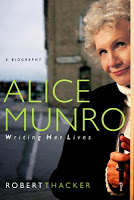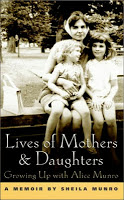Alice Munro, one of our national literary treasures, has been awarded the ultimate international literary prize, The Nobel Prize in Literature. Way to go Alice!
Beyond reading her wonderful fiction, you may wish to also find out more about her life.
Where did she grow up, how did she develop as a writer, who were her influences, what was the impact on her family, etc….
Listed below are books about Alice Munro’s life and her impact and influence on the literary scene, both at home and abroad.
Alice Munro: writing her lives: a biography (M) also: ebook
by Robert Thacker
 This is the book about one of the world’s great authors, Alice Munro, which shows how her life and her stories intertwine. For almost thirty years Robert Thacker has been researching this book, steeping himself in Alice Munro’s life and work, working with her co-operation to make it complete. The result is a feast of information for Alice Munro’s admirers everywhere.
This is the book about one of the world’s great authors, Alice Munro, which shows how her life and her stories intertwine. For almost thirty years Robert Thacker has been researching this book, steeping himself in Alice Munro’s life and work, working with her co-operation to make it complete. The result is a feast of information for Alice Munro’s admirers everywhere.
By following “the parallel tracks” of Alice Munro’s life and Alice Munro’s texts, he gives a thorough and revealing account of both her life and work. “There is always a starting point in reality,” she once said of her stories, and this book reveals just how often her stories spring from her life. The book is chronological, starting with her pioneer ancestors, but with special attention paid to her parents and to her early days growing up poor in Wingham. Then all of her life stages — the marriage to Jim Munro, the move to Vancouver, then to Victoria to start the bookstore, the three daughters, the divorce, the return to Huron County, and the new life with Gerry Fremlin — leading to the triumphs as, story by story, book by book, she gains fame around the world, until rumours of a Nobel Prize circulate . . .
Lives of Mothers and Daughters: growing up with Alice Munro (M)
by Sheila Munro
 Novelist and short-story writer Alice Munro’s many readers are certain to find this an intriguing memoir. It is the first book by Munro’s daughter, Sheila, now a mother of two children and an aspiring writer living in British Columbia. The book seems in many ways a typical family story, replete with abundant photographs from the family album, images from the 50s through the 90s that would look perfectly comfortable spread out on the coffee table of almost any middle-class North American home. What makes the book extraordinary are the extraordinary accomplishments of the mother under consideration–Alice, a woman who somehow managed to integrate domesticity with a writer’s life and who did it, by Sheila’s account, with considerable grace and intelligence. Mommie Dearest this is not. Alice Munro’s readers will be especially interested in Sheila’s descriptions of family events that worked their way into her mother’s stories. – Booklist
Novelist and short-story writer Alice Munro’s many readers are certain to find this an intriguing memoir. It is the first book by Munro’s daughter, Sheila, now a mother of two children and an aspiring writer living in British Columbia. The book seems in many ways a typical family story, replete with abundant photographs from the family album, images from the 50s through the 90s that would look perfectly comfortable spread out on the coffee table of almost any middle-class North American home. What makes the book extraordinary are the extraordinary accomplishments of the mother under consideration–Alice, a woman who somehow managed to integrate domesticity with a writer’s life and who did it, by Sheila’s account, with considerable grace and intelligence. Mommie Dearest this is not. Alice Munro’s readers will be especially interested in Sheila’s descriptions of family events that worked their way into her mother’s stories. – Booklist
Mothers and Other Clowns : the stories of Alice Munro (M)
by Magdalene Redekop
“This study of the work of Alice Munro focuses on her obsession with mothering, relating it to the hallucinatory quality of her magic realism. A bizarre collection of clowning mothers parade across the pages of Munro’s fiction, playing practical jokes, performing stunts, and dressing in thrift shop disguises that recycle vintage literary images. Paying close attention to their mimicries, Magdalene Redekop studies this parade with the aim of gaining increased understanding of Munro’s evolving comic vision. As the outlines of her aesthetic are delineated, it becomes clear that it involves a new way of looking at autobiography and a new way of looking at narrative sequence. This book should be of interest to undergraduates and academics of literature, particularly Canadian literature and women’s studies.” – publisher
The Rest of the Story: critical essays on Alice Munro (M)
edited by Robert Thacker
 “Since the early 1950s Alice Munro has been writing stories that have absorbed, intrigued, and even troubled her readers. In this critical analysis, leading critics explore the myriad connections informing Munro’s deceptively simple tales. Munro’s 1996 story, “The Love of a Good Woman,” receives particular attention, because in it she looks back on and forward to her unfolding career as a writer. Insights into Munro’s relationship with her agent, Virginia Barber, and with the New Yorker, also reveal a great deal about the development of Munro’s career and her vocation. Together, the essays explore Munro’s art in its full accomplishment, treating broadly both its process and its achievement.” – publisher
“Since the early 1950s Alice Munro has been writing stories that have absorbed, intrigued, and even troubled her readers. In this critical analysis, leading critics explore the myriad connections informing Munro’s deceptively simple tales. Munro’s 1996 story, “The Love of a Good Woman,” receives particular attention, because in it she looks back on and forward to her unfolding career as a writer. Insights into Munro’s relationship with her agent, Virginia Barber, and with the New Yorker, also reveal a great deal about the development of Munro’s career and her vocation. Together, the essays explore Munro’s art in its full accomplishment, treating broadly both its process and its achievement.” – publisher




